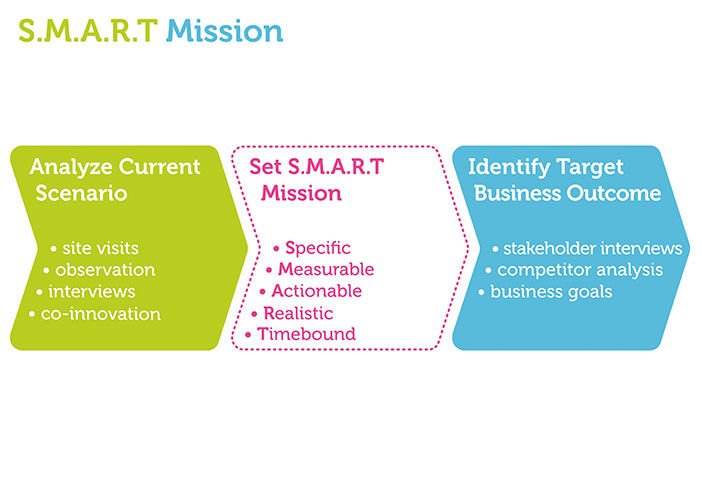"Begin with the end in mind"
"Seek first to understand, then to be understood"
— Stephen Covey
Mission refers to the goal of your gamification activity. It has to be identified with care, since it determines the ultimate success or failure of your efforts. In this chapter we will discuss the aspects to consider when choosing a meaningful mission that can be used internally by the gamification team to guide their endeavors.
4.1 Steps to create an effective mission
The key aspects to consider in setting an effective mission are:
Begin with a good understanding of the problem you are trying to solve, and the outcome you are trying to achieve; based on this understanding, set a S.M.A.R.T mission.
Let us examine each of these steps in detail.
 Courtesy of Janaki Kumar and Mario Herger. Copyright: CC-Att-ND (Creative Commons Attribution-NoDerivs 3.0 Unported).
Courtesy of Janaki Kumar and Mario Herger. Copyright: CC-Att-ND (Creative Commons Attribution-NoDerivs 3.0 Unported).
Figure 4.1: Analyze current scenario, understand target business outcome and set a S.M.A.R.T. mission
4.1.1 Analyze Current Situation
The current scenario is what the players do today. It involves studying the work practices currently followed by the employee, customer, or partner.
The best way to get this information is through qualitative research such as observation, site-visits and interviews. The goal is to develop a strong empathy with the target players. An effective way to do this is through Design Thinking (footnote 1) a methodology offered by the design school, Hasso Plattner Institute of Design at Stanford University (footnote 2).
If the gamified software is for internal use, it is relatively easy to access the target player. If the gamification is part of standard software, however, the level of customer intimacy required may not be achievable through the normal recruiting processes. To overcome this issue, we recommend establishing Co-Innovation Partnerships with a few key customers. For more information on Co-Innovation Partnerships, refer to Appendix A.12.
4.1.2 Understand the target business outcome
On a high level, the target scenario is what the management wants employees, customers or partners to do. For example, they may want sales reps to sell more, customers to buy more. However, this is too high level and we need to go deeper to create an effective mission.
The best way to get this information is to interview stakeholders to understand the behavior change they wish to see in the organization.
4.1.3 Identify a S.M.A.R.T. mission
Based on an analysis of the current scenario, and an understanding of the target scenario, we can identify a mission for our gamification project. We recommend that the gamification mission be specific, measurable, actionable, realistic and time-bound. These elements are encapsulated in the acronym S.M.A.R.T.
Let us examine the applications of these dimensions in defining a mission in the following case:
Company A's call center has a low customer satisfaction score. Management have examined the cause of this problem and identified that call center agents are not sufficiently knowledgeable about their new product's features and functions, and are therefore not able to provide satisfactory answers to customer questions. The company has provided on-line training materials for the agents. However, only 10% of the agents have completed the training. The company decides to try gamification to motivate the agents. What is an appropriate Mission for this enterprise gamification project?
For the above case, we do not recommend you choose "Increase Customer Satisfaction" as your gamification mission. Although it is somewhat specific and measurable, it is not actionable, or time-bound.
Rather, we recommend that you look at the root cause relating to lack of training. A more effective mission is to "Increase completion of training activity to 80% in 3 months". This mission is specific, can be measured, is actionable by players, and time-bound. To know if it is realistic in the given time frame, we need to examine the current scenario and the target scenario.
4.1.4 Additional guidelines for Mission Selection
4.1.4.1 Do not get in the way
Engagement is an important part of any gamification mission. However, select the part of the application to be gamified with care, and select your mission accordingly. Enterprise software's primary objective is about achieving specific business outcomes. Therefore, ensure that gamification does not get in the way of such critical business processes.
4.1.4.2 Embrace iteration
Player centered design is iterative. Therefore, information learned at later stages in the process may shed more light on previous stages. For example, during the course of analyzing the current scenario, understanding target scenarios, and identifying the mission, we may learn more about the player. If this were to happen, we can go back and adjust our player persona based on this new information. Iteration is the key to any innovative endeavor, including gamification.
The mission of gamification could be revisited for new releases of the application to maximize business outcome.
4.2 Mission examples
Here are a few non-enterprise examples to illustrate how to identify a mission:
4.2.1 Example: Everyday fitness
This is what a team did in the Volkswagen project Piano staircase. Check out the video at: Source: http://www.thefuntheory.com/piano-staircase
 Copyright © Volkswagen. All Rights Reserved. Used without permission under the Fair Use Doctrine. See the "Exceptions" section (and subsection "fairUse") of the copyright notice.
Copyright © Volkswagen. All Rights Reserved. Used without permission under the Fair Use Doctrine. See the "Exceptions" section (and subsection "fairUse") of the copyright notice.
Figure 4.2: Piano Staircase
4.2.2 Example: Driving below speed limit
This is the story of Speed Camera lottery that started as a Volkswagen fun project, and was later implemented in Sweden where it reduced average speed from 35 km to 25 km/hour. Check out the video at http://www.thefuntheory.com/speed-camera-lottery-0
 Copyright © Volkswagen. All Rights Reserved. Used without permission under the Fair Use Doctrine. See the "Exceptions" section (and subsection "fairUse") of the copyright notice.
Copyright © Volkswagen. All Rights Reserved. Used without permission under the Fair Use Doctrine. See the "Exceptions" section (and subsection "fairUse") of the copyright notice.
Figure 4.3: Camera lottery
4.2.3 Enterprise Example: What is in a name?
Every time an employee logs in, he/she is presented with a co-worker's face and three possible names. The employee identifies the co-worker, and gets to learn a little bit about them.
4.3 Summary
The mission refers to the goal of the gamification activity. Setting a good goal for the gamification project involves understanding the current scenario, and target business outcome, and setting an appropriate mission for your gamification project.
Engagement is an important part of any gamification mission. However, in the enterprise context, ensure that gamification does not get in the way of a person's core job. Select a S.M.A.R.T. mission, to allow the team to measure the success of their gamification strategy against this agreed-upon mission.
4.4 Insights from SAP Community Network
Having created a player persona, the next step was to identify the mission.
The original assumption was that the most frequent participants in the community would be consultants and IT professionals from large companies. However, it turned out that a large number of early contributors were independent consultants or members of smaller IT teams. They welcomed the connection to other developers. They participated actively in the community and shared their expertise generously. This created a positive momentum, and made visible the helpful and generous spirit of the community. Soon, this encouraged employees from larger companies to engage with a similar community spirit, and they started sharing their knowledge for the benefit of everyone.
The mission of SCN, to share information, learn, and connect with others, was appealing to SAP professionals who did not have a large network of their own. They saw this as an opportunity to become visible to a wider audience.
To be continued at the end of next chapter...

